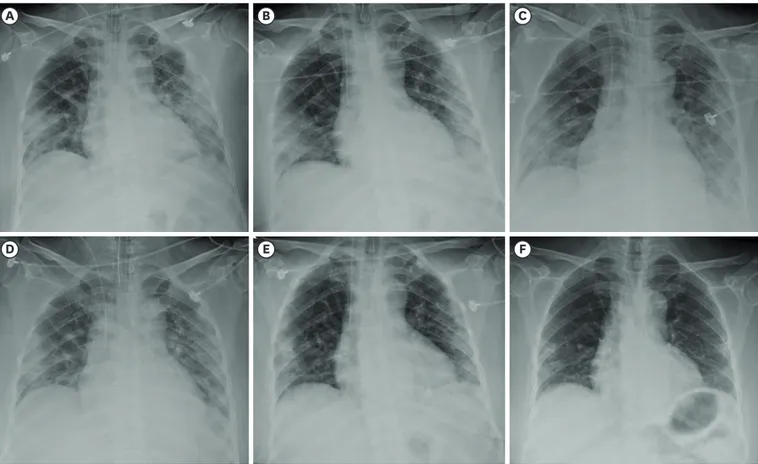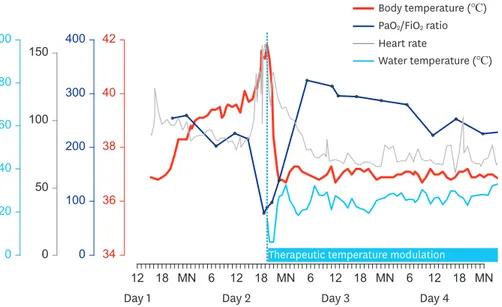ABSTRACT
We report a rapidly deteriorating coronavirus disease 2019 (COVID-19) patient, a-58-year- old woman, with severe acute respiratory distress syndrome and shock with hyperpyrexia up to 41.8°C, probably due to the cytokine storm syndrome. Considering extracorporeal membrane oxygenation (ECMO) as the last resort, we applied therapeutic temperature modulation for management of hyperpyrexia. The patient demonstrated rapid improvement in oxygenation and shock after achieving normothermia, and fully recovered from COVID-19 three weeks later. Therapeutic temperature modulation may have successfully offloaded the failing cardiorespiratory system from metabolic cost and hyperinflammation induced by hyperpyrexia. The therapeutic temperature modulation can safely be applied in a specific group of patients with cytokine storm syndrome and hyperpyrexia, which may reduce the number of patients requiring ECMO in the global medical resource shortage.
Keywords: SARS-CoV-2; COVID-19; Fever; Therapeutic Temperature Modulation
INTRODUCTION
The cytokine storm syndrome, which rapidly progress to acute respiratory distress syndrome (ARDS), shock, and multiorgan dysfunction, has been observed in a subgroup of patients with severe coronavirus disease 2019 (COVID-19).1,2 Several therapeutic measures, including steroids and cytokine blockade, have been suggested.3 We present the case of a COVID-19 patient whose condition rapidly deteriorated with hyperpyrexia but was successfully managed with therapeutic temperature modulation (TTM).
CASE DESCRIPTION
On March 5, 2020, a-58-year-old woman was transferred to our intensive care unit (ICU) due to acute hypoxemic respiratory failure. The patient was previously diagnosed with COVID-19 on a screening test for throat discomfort 12 days earlier. The patient lived in Daegu, the epicenter of COVID-19 in Korea, and had acquired the infection through community eISSN 1598-6357·pISSN 1011-8934
Case Report
Received: Apr 21, 2020 Accepted: May 28, 2020 Address for Correspondence:
Young-Jae Cho, MD, MPH, PhD Division of Pulmonary and Critical Care Medicine, Department of Internal Medicine, Seoul National University College of Medicine, Seoul National University Bundang Hospital, 173 Gumi-ro 173-beon-gil, Bundang-gu, Seongnam 13620, Republic of Korea.
E-mail: lungdrcho@gmail.com
*Han-Gil Jeong and Yunghee Lee equally contributed to this work.
© 2020 The Korean Academy of Medical Sciences.
This is an Open Access article distributed under the terms of the Creative Commons Attribution Non-Commercial License (https://
creativecommons.org/licenses/by-nc/4.0/) which permits unrestricted non-commercial use, distribution, and reproduction in any medium, provided the original work is properly cited.
ORCID iDs Han-Gil Jeong
https://orcid.org/0000-0002-1418-1768 Yunghee Lee
https://orcid.org/0000-0001-9431-0621 Kyoung-Ho Song
https://orcid.org/0000-0002-4517-3840 In-Chang Hwang
https://orcid.org/0000-0003-4966-3924 Eu Suk Kim
https://orcid.org/0000-0001-7132-0157 Young-Jae Cho
https://orcid.org/0000-0001-6943-4462
Han-Gil Jeong ,1* Yunghee Lee ,2* Kyoung-Ho Song ,3 In-Chang Hwang ,4 Eu Suk Kim ,3 and Young-Jae Cho 2
1 Division of Neurocritical Care, Department of Neurosurgery and Neurology, Seoul National University Bundang Hospital, Seongnam, Korea
2 Division of Pulmonary and Critical Care Medicine, Department of Internal Medicine, Seoul National University Bundang Hospital, Seongnam, Korea
3 Division of Infectious Diseases, Department of Internal Medicine, Seoul National University Bundang Hospital, Seongnam, Korea
4 Division of Cardiology, Department of Internal Medicine, Seoul National University Bundang Hospital, Seongnam, Korea
Therapeutic Temperature Modulation for a Critically Ill Patient with COVID-19
Respiratory Critical Care
Disclosure
The authors have no potential conflicts of interest to disclose.
Author Contributions
Formal analysis: Jeong HG. Investigation:
Jeong HG, Lee Y, Song KH, Hwang IC, Kim ES, Cho YJ. Methodology: Jeong HG, Lee Y, Cho YJ. Supervision: Song KH, Cho YJ. Writing - original draft: Jeong HG, Lee Y. Writing - review & editing: Jeong HG, Song KH, Cho YJ.
spread. Seven days before ICU admission, the patient was diagnosed with pneumonia and started lopinavir/ritonavir 400 mg/100 mg tablets twice a day and supplemental oxygen was started 3 days ago. Vital signs on presentation to the ICU were: blood pressure 145/90 mmHg, pulse rate 90/min, respiratory rate 32/min, and body temperature 36.9°C. Arterial blood gas analysis showed pH 7.383, partial pressure of carbon dioxide (pCO2) 33.5 mmHg, partial pressure of arterial oxygen (PaO2) 83.9 mmHg, and bicarbonate (HCO3-) 19.5 mmol/L on high-flow nasal cannula (fraction of inspired oxygen [FiO2], 0.95; flow rate, 50 L/min).
The patient was intubated and placed on mechanical ventilation with elaborate lung- protective strategies.4 The PaO2 improved to 229.1 mmHg on FiO2 0.9, and we initiated intravenous methylprednisolone 60 mg. A chest radiograph showed bilateral, multifocal, patchy consolidations in the lungs (Fig. 1). The C-reactive protein level was 22.9 mg/dL.
Nasopharyngeal and oropharyngeal swabs as well as sputum specimens were obtained for retesting at our hospital and reported positive for infection with the novel severe acute respiratory syndrome coronavirus 2 (SARS-CoV-2) by real-time reverse-transcriptase–
polymerase-chain-reaction (RT-PCR) assay.
From the evening on Day 1 of hospitalization, the patient's body temperature began to increase, reached approximately 40°C on Day 2, and was followed by tachycardia and desaturation (Fig. 2). The fever was refractory to repeated administration of antipyretics. The body temperature increased up to 41.6°C, heart rate to 156 per min, and oxygen saturation decreased to 88% on FiO2 of 1.0. Nitric oxide (NO) inhalation was initiated and raised to 40 ppm, and injection of methylprednisolone 60 mg was repeated. However, arterial blood gas analysis showed PaO2 of 77.6 mmHg, and the troponin I level increased to 6.22 ng/mL.
B A
D
C
F E
Fig. 1. Chest radiographs on (A) Day 1, (B) Day 2, (C) Day 3, (D) Day 5, (E) Day 8, and (F) Day 22 of hospitalization.
Considering extracorporeal membrane oxygenation (ECMO) as the last resort for treatment, we applied a surface cooling device (Arctic Sun®) with a target temperature of 37°C. From an initial core temperature of 41.8°C, the target temperature was rapidly attained within 4.5 hours. PaO2 was markedly improved to 318.2 mmHg, and tachycardia resolved after a few hours. The norepinephrine requirement that had increased up to 16 µg/min during the shock phase was tapered off. Echocardiography on Day 4 showed mid-to-apical-segment akinesia and depressed left ventricular systolic function with an ejection fraction of 26%. The patient was extubated on Day 6 and TTM was stopped on Day 9. Other treatment details including antibiotics and steroid use are summarized in Table 1. On Day 12, SARS-CoV-2 RT PCR results converted negatively in all nasopharyngeal, oropharyngeal, and sputum specimens.
Supplemental oxygen was discontinued on Day 16, and the patient's cardiac function was confirmed to have recovered on Day 19 with an ejection fraction of 54%. A coronary computed tomographic angiography was also normal. A chest radiograph on Day 22 showed considerable improvement compared to the previous ones (Fig. 1).
DISCUSSION
The patient presented with mild ARDS but rapidly progressed to severe ARDS and shock with hyperpyrexia, probably due to a hyperinflammatory syndrome. However, the patient demonstrated rapid improvement in oxygenation and shock after the initiation of TTM. Pyrexia confers a metabolic cost, which increases oxygen consumption by 10% per degree Celsius rise in temperature.5 Therefore, rapid reduction in core temperature by 5°C successfully offloaded the patient's failing cardiorespiratory system. The hyperinflammatory response and hyperpyrexia may have a reciprocal synergism, wherein uncontrolled inflammation promotes thermogenesis and vice versa, and this vicious cycle may have been forcibly terminated by TTM.6
The pandemic caused by SARS-CoV-2 infection has necessitated several management strategies, although many have not been concretely established as conferring a patient
34 36 38 40 42
0 100 200 300 400
0 50 100 150
0 20 40 60 80 100
12 18 MN 6 12 18 MN 6 12 18 MN 6 12 18 MN Therapeutic temperature modulation
Day 1 Day 2 Day 3 Day 4
Body temperature (℃)
Water temperature (℃) PaO2/FiO2 ratio Heart rate
Fig. 2. Body temperature, the ratio of partial pressure of arterial oxygen and fraction of inspired oxygen (PaO2/FiO2), and heart rate during hyperpyrexia with subsequent changes indicating the effect of therapeutic temperature modulation.
Table 1. Clinical course, laboratory findings, and management of the patient Hospital day−12−7−31234567891011121314151617181920 Clinical symptom/signHA, sore throat
PneumoniaHypoxiaMild ARDSHyper- pyrexia
shock severe ARDS
Mild ARDS SARS-CoV-2+++−+−−− White cell count, 103/μL6.74.2 → 8.39.28.17.78.619.418182114.614.312.412.213.411.58.29.5 Lymphocyte, %6.520.1 → 35.521.110.610.37.753.65.84.85.45.97.29.88.29.110.59 C-reactive protein, mg/ dL22.916.55.53.02.11.91.20.62.45.12.81.81.00.80.80.5< 0.4 APACHE II8 SOFA scorea610989656553332221 PaO2/FiO2242233333322122211 Platelet count000000000000000000 GCS01111111111110000000 Bilirubin112222110100000000 MAP or vasopressor34433001100010000000 Creatinine0000000000000000000 Antiviral agentLopinavir/Ritonavir for 2 weeks Antibacterial agentsPiperacillin/Tazobactam for 8 days Moxifloxacin for 7 days MethylPd, mg606060606030606030301515 Respiratory supportO2HFNC → MVMV + iNOMVHFNCO2Room air Troponin I, ng/mL0.0076.22 → 13.0
5.93 → 32. .92
55 → 1.93
1.020.540.150.160.100.07 proBNP, pg/mL4759,68416,3679,5728,9094,8891,4222,005 ECGNSRSTET-inv [V3-V6]T-inv [V1-V6]T-inv [V1-V6]Normal-T
NS- IVCD LVEF26%39%54% TTMTarget: 37°C e the wor.sts indicatd numberBol ory syndruation II, valalth Eonic Heogic Assessment and Chrysiole PhACHE II = Acut, APvirus 2onaome core acutatory distrHA = headache, ARDS = acutespirespirate ress syndrome, SARS-CoV-2 = severe r e, Meth, MV = mechanical al cannulaflow nasone, HFNC = high-ednisolylprenous methd = intrylPavessururerial prA = Sequential Organ FailSOFe Assessment, GCS = Glasgow Coma Scale, MAP = mean art ythm, STE = ST elspecific sion, NS-IVvere inav-wv = T-inevation, TCD = non-am, NSR = normal sinus rhoBNP = prventilation, iNO = inhaldiogrxide, pred nitric oo-brain natriuretic peptide, ECG = electrocar ulation.e modaturemperapeutic tTM = thery, Taphdiograction on echocareft vVEF = ly, Luction delaentricular condavintrentricular ejection fr aong with their rscore sub-espectivItems of the SOFow aled bele liste arA scores.
benefit. ECMO can serve as a life-saving rescue therapy, although concerns exist about potential adverse effects of ECMO therapy for patients with COVID-19.7 The therapeutic temperature modulation may safely be applied in a specific group of patients with cytokine storm syndrome and hyperpyrexia. If efficacy and safety can be demonstrated through further studies, targeted therapeutic modulation will reduce the number of patients requiring ECMO in the global medical resource shortage. Despite the potential contribution of pyrexia to host defense, the dramatic response to TTM in this patient suggests that the severe metabolic stress induced by hyperpyrexia may be considerably more harmful than beneficial in the hyperinflammatory stage of SARS-CoV-2 infection.
Ethics statement
The Institutional Review Board of Seoul National University Bundang Hospital approved the publication of this report, and written informed consent was waived (B-2005-611-701).
REFERENCES
1. Mehta P, McAuley DF, Brown M, Sanchez E, Tattersall RS, Manson JJ, et al. COVID-19: consider cytokine storm syndromes and immunosuppression. Lancet 2020;395(10229):1033-4.
PUBMED | CROSSREF
2. Chen N, Zhou M, Dong X, Qu J, Gong F, Han Y, et al. Epidemiological and clinical characteristics of 99 cases of 2019 novel coronavirus pneumonia in Wuhan, China: a descriptive study. Lancet 2020;395(10223):507-13.
PUBMED | CROSSREF
3. Siddiqi HK, Mehra MR. COVID-19 illness in native and immunosuppressed states: a clinical-therapeutic staging proposal. J Heart Lung Transplant 2020;39(5):405-7.
PUBMED | CROSSREF
4. Cho YJ, Moon JY, Shin ES, Kim JH, Jung H, Park SY, et al. Clinical practice guideline of acute respiratory distress syndrome. Tuberc Respir Dis (Seoul) 2016;79(4):214-33.
PUBMED | CROSSREF
5. Doyle JF, Schortgen F. Should we treat pyrexia? And how do we do it? Crit Care 2016;20(1):303.
PUBMED | CROSSREF
6. Evans SS, Repasky EA, Fisher DT. Fever and the thermal regulation of immunity: the immune system feels the heat. Nat Rev Immunol 2015;15(6):335-49.
PUBMED | CROSSREF
7. Henry BM. COVID-19, ECMO, and lymphopenia: a word of caution. Lancet Respir Med 2020;8(4):e24.
PUBMED | CROSSREF


